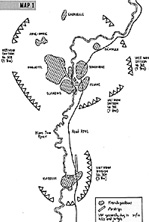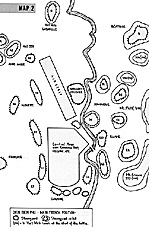The second part of a two part feature, this issue tackles wargaming Dien Bien Phu. See Part 1 in Issue 4 for the background and historical details of this battle.
Wargaming Dien Bien Phu
The battle of Dien Bien Phu offers a wide variety of arms and tactics on a manageable scale. You can combine droppings of paratroops and supplies with trench warfare, airstrikes and sorties into the jungle. Troops types vary from crack (Foreign Legion paratroops) to unreliable (T'ai).
Wargaming The Whole Battle
If you want to play the whole battle, 6mm is the right scale and Command Decision seems to be one of the better sets of rules for this type of game. Figures are not problem. For those not wishing to buy new figures, let alone point them: the French can easily be represented by WW2 American troops: a mixture of infantry, paratroops and marines, maybe with a sprinkle of British paratroops and Australians. For the Vietnamese: use EVA of the Second Vietnam war. If these are not available and you are playing on the 6mm scale, maybe a mixture of WWII British and Japanese with a few extra stands with the Viet Minh-flag could do.
Playing One Scenario
The article gives sufficient information to create a few interesting scenarios. One possibility is the start of Operation Castor, in which three crack paratroop-battalions are dropped and have one day to clear the valley.
In this scenario, Viet Minh-forces are umpire-controlled. Their strength is unknown to the French players. In reality, there were only two companies (plus two heavy weapons companies), but what if there had been one or even two battalions? Note that, at the time of the initial French drop, there were no fortifications but instead some ten small villages, spread all over the valley. Another good idea might be the attack on Gabrillle by six Viet Minh battalions (with plenty of artillery support). Gabrillle is defended by the entrenched crack 3/13 DBLE. When you decide to play a scenario, 20mm seems advisable.
Role Playing or Skirmish Games
The story of captain Maurel and his crew could be used as the basis of a role playing-game. The Dakota of Captain Maurel was circling above Dien Bien Phu on 13 March at 17:00, just when the Viet Minh started their massive bombardment. As the Dakota landed, it was hit by mortar fire. The plan immediately caught fire, but no one was hurt and the crew managed to escape. Maurel and his men discovered that they had run into a minefield around Isabelle. Fortunately, they got out without losses. In the meantime, a legionnaire had arrived with a Dodge to pick them up, but half way the car broke down. Night fell and it started to rain. For several hours and while the battle was raging, the crew and the legionnaire wandered between friendly and enemy lines. Next morning, some French soldiers found them sleeping in a hole in the ground.
French Weapons And Uniforms
France was almost ruined by the Second World War, so the Expeditionary Corps had to make do with what it could find. The forces were equipped with US, British and WW2 French material, giving them a makeshift appearance. Different types of combat clothing were worn in a bewildering number of combinations. In the late 1940s, most French troops were dressed in khaki drill or jungle green. By 1950, camouflage uniforms became the norm at least in the parachute units. Combinations of US Marine camouflage jackets with British ('SAS') trousers were very popular. Webbing equipment was mainly American with some British items. The characteristic field headgear was the French bush hat in khaki drill, green drab or camouflage, often worn in 'Aussie-fashion' (right brim up) or 'cowboy-style' (both sides up).
The issue steel helmet was the US M1, sometimes locally modified. Berets were worn also and some Foreign Legion officers insisted on wearing their white kepis even on the battlefield. By 1953, the French armament of the start of the Indo-China War (MAS36-rifle, MAS28-SMG, FM24/29-LMG,...) was replaced by American material (M1A1 carbine, Thompson, Browning .30, 60mm and 81mm mortars, 57mm RCL, M24 Chaffee tank, 105mm guns and 155mm howitzers,...)
The French Air Force
On November 20th 1953, the ArmEe de I'Air d'Indochine had 79 fighters (Bearcat F8F), 18 recce-planes (RF8F), 35 bombers (B26) and 74 transport-aircraft (mostly Dakota, some C119 'Packet' flown by American volunteers). At the start of the battle, the Navy Air force (ArEonavale) had 33 fighters (Hellcat F6F), 8 bombers (Privateer PB4Y2) and 3 transporters (2 Dakota and 1 Ju52). There were also 5 helicopters. At least 3 of the latter were used to evacuate the wounded. Later, SB2C Helldivers and Corsairs wee used as well.
In spring 1054, the GMMTA (Groupement des moyens militaires de transport aErien, transl.: Military Air Transport Group) was composed of four groups (named Anjou, Franche-ComtE, BEarn and SEnEgal) which had some 100 DC3 Dakotas. But only some 60 were permanently operational and only 30 were assigned to the supply of Dien Bien Phu. The Dakotas, with a transport capacity of 2.6 tons or 24 men, could only deliver about half of the 150 tons that were daily needed (assuming that nothing fell into Viet Minh-hands). The difference was made up by the C119 Fairchild Packett (Flying Boxcar) of Chennault's "American Civil Air Transport" with mixed Franco-American crews. These Americans were little more than mercenaries, being paid extremely well. But for the French command, it was easier to pay these men than to convince their politicians to send more pilots from metropolitan France. The C119 had a capacity of 6 tons or 78 men.
Soon, the French were also short of parachutes. In total, 62,000 parachutes would be used, a large number of them supplied by the United States.
Air Force losses were heavy. J. Roy mentions 28 planes destroyed in the air (or which 11 by Viet Minh-flak and 17 for other reasons), 20 planes destroyed on the ground by artillery and 14 planes destroyed on the ground by Viet Minh-commandos.
(Other sources give different figures). Most transport planes were severely hit on one or more occasions: J. Roy mentions 176 planes hit by Viet Minh-flak.
During the night, the French permanently had a "Luciole" circling above the camp: a Dakota from which the crew threw out flares through an open door.
The rules should reflect the limited effect of the French air strikes (due to bad weather and brilliant Viet Minh camouflage).
More Dien Bien Phu:
To Dien Bien Phu (Part 1 in Vol. 1 issue 4)
I only mention the books in English. Unfortunately, the best books on the battle of Diem Bien Phu are in French.
Fall, B. Hell in a Very Small Place.
"Battle for Dien Bien Phu"
As Karim points out, for those of us (English) interested in the French war in Indo China there is a distinct lack of information. With this in mind I'll expand the above reference list which I hope will be of use to other English readers interested in finding out more about this neglected conflict.
Simpson, H. Dien Bien Phu, The Epic Battle America Forgot, Brassey's., 1994.
Although not covering Dien Bien Phu the following auto biographical accounts of the war in Indo China are also of interest:
Aparvary, L. A Legionnaire's Journey, Detselig Enterprises Ltd., 1989.
Both 'Hell in a Very Small Place' & 'Street Without Joy' should be on the bookshelves of anyone interested in Vietnam since 1945 (and probably on the shelves of anyone interested in military history). If you have 'Hell in a Very Small Place' then you probably don't need Simpson's account of the battle (conversely, this is a good general introduction to the battle). Dalloz is the political background to the war and somewhat heavy going but is very useful for setting the battlefield in a wider context. I believe the English translation of Roy is somewhat shorter than the French original but is still a very good account of the battle. My edition was published by Carroll & Graf Inc., 1984.
Citadel by Frank Chadwick is a board wargame covering the entire battle. Sadly long out of print it is superb- if you're interested in this battle beg, steal or borrow a copy of this!
This article appears in MagWeb (Magazine Web) on the Internet World Wide Web. Larger version of Map at right (88K).
Larger version of Map at right (88K).
 Larger version of Map at right (92K).
Larger version of Map at right (92K).
The Editor Speaks about Dien Bien Phu
Dien Bien Phu Order of Battle
Dien Bien Phu VM Infantry Division Organization
Selected Bibliography
Fall, B. Street Without Joy.
Keegan, J. Dien Bien Phu, Ballantine, Illustrated History of the Violent Century, Random House In., 1974.
Roy, J. Dien Bien Phu.
Windrow, M. French Foreign Legion; and
Braby, W. Paratroops, Osprey Elite Series, London, 1985. 64 pp.
Video & Film
Visions of War, Special Network. (Video)
"Dien Bien Phu" by Pierre Schondorfer. (Film)
Editor
Dalloz, J. The War in Indo China (trans. J. Baker), Barnes & Noble Ltd., 1990.
de Pirey, P. Operation Waste (trans. P. Search), Arco 1954.
Chadwick, F. Citadel, GDW., 1977.
Back to Battlefields Vol. 1 Issue 5 Table of Contents
© Copyright 1996 by Partizan Press.
Other military history articles and gaming articles are available at http://www.magweb.com